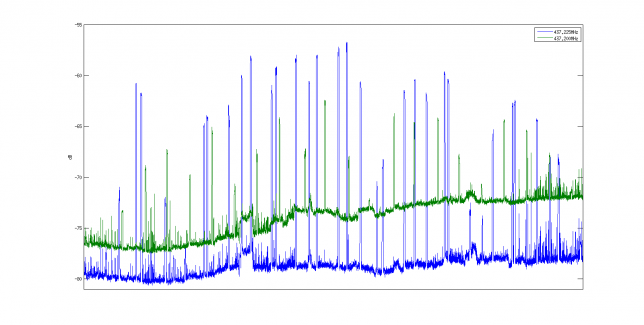In a previous post, I recorded and decoded LilacSat-2 telemetry. This satellite transmits telemetry on 437.200MHz and 437.225MHz using two different radios and antennas, as can be seen in the radio info page. The transmission on 437.200MHz is usually 9k6 BPSK telemetry, but this is the same frequency, radio and antenna that is used for the amateur FM transponder when it is active. Looking at the waterfall as I recorded the IQ, I had the impression that the signal on 437.200MHz was much weaker than the signal on 437.225MHz. Using my LilacSat-2 receiver and the IQ recording I did, I have plotted the signal strength on both frequencies to compare.
The signal strength file that the receiver outputs has been processed in MATLAB with a moving average filter to smooth out the noise spikes, which were quite distracting when judging the plots by eye. The plot of the signal strength is shown below. It is in uncalibrated dB units, which is enough for relative measurements.
The signal strength at 437.200MHz is shown in green and the signal strength at 437.225MHz is shown in blue. The large spikes correspond to telemetry transmissions, and the rest is just the noise floor. The difference in noise levels accounts for the different bandwidth used to receive each frequency and for the fact that the noise floor in the FUNCube Dongle Pro+ passband is not constant. This is only relevant in UHF and above, where ambient noise is small. We can see that the noise at 437.200MHz increases with respect to the noise at 437.225MHz as the pass progresses, because the Doppler shift moves the 437.200MHz signal into a region of the passband of the dongle where the noise floor is higher.

The 437.200MHz signal is consistently about 5 to 10dB weaker than the 437.225MHz signal. It also seems to suffer more fading, as there are some quite weak packets received in the middle of the pass. Both transmissions are circularly polarized and were received with a linearly polarized yagi, so polarization should not be an important factor here.
Another interesting thing to note is that the packet transmission intervals can be easily extracted from this plot. The 9k6 BPSK telemetry at 437.200MHz transmits at a regular interval, but the 4k8 GFSK telemetry at 437.225MHz seems a bit random. There are some times where a two packets are transmitted with little delay between them.
Some amateurs have reported to experience quite some fading on the FM transponder downlink, so it would be interesting to do the same experiment when the transponder is running.